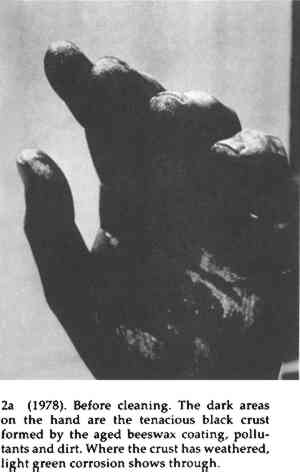CONSERVATION OF A MONUMENTAL OUTDOOR BRONZE SCULPTURE: THEODORE ROOSEVELT BY PAUL MANSHIPLynda A. Zycherman, & Nicolas F. Veloz
2 CONDITIONFOR NEARLY A DECADE and a half, the sculpture has been standing in a site ringed by five major commuter routes carrying 400,000 cars a day and directly under the north approach to the Washington National Airport. Dirt and pollutants had so heavily accumulated in the wax coat that the statue's color was dull black. Details of the hair and jewelry were obscured by the accumulation of wax and dirt and the dull black surface. In contrast to the overall black color, patches of light green corrosion appeared on the head, shoulders, lapels, proper left forearm, tops of both hands and both shoes, the proper right skirt of the frock coat, and the sides of the metal base—areas that are particularly exposed to water and wind-borne particle abrasion (Figure 2a). The brazed join high up at the underside of the frock coat/backs of the thighs was the most corroded area of the sculpture; presumably because of its inaccessibility, this join was less well finished than the others and had not been waxed. Light rain streaking disfigured the broader planes of the bronze. Some corrosion may have been effected by bird droppings, but there is no reason to doubt that most was atmospherically induced. The brazed joins, with the exception of the one under the frock coat already mentioned, were unmarred by an efflorescing core or post-manufacture attack by a corrosive flux. The bronze plugs remained even with the surface both in color and height.
The bronze sculpture's state of preservation was good, but aesthetically, it had changed dramatically since its dedication. The curator (N.V.) decided that the Theodore Roosevelt should be cleaned. |
